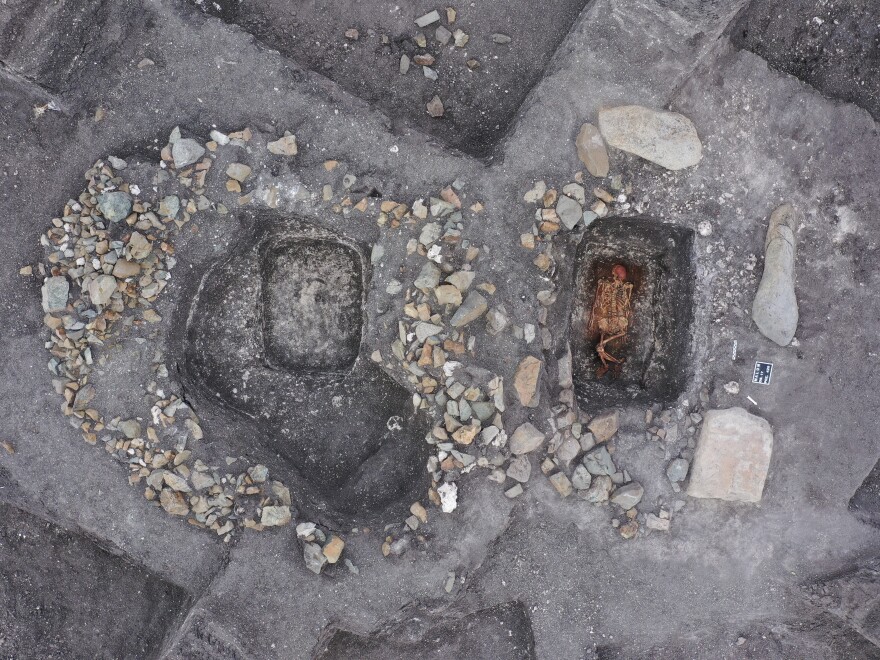Horseback riding was likely a common activity as early as 4,500 to 5,000 years ago, according to a provocative new study that looked at human skeletal remains for small signs of the physical stress associated with riding horses.
People first started keeping horses about 5,500 years ago, initially for their meat and milk, researchers believe. But how and when horses became a transformative mode of transportation isn't so clear.
"Cattle and sheep and goats were domesticated thousands of years before horses were. And horses are different from cattle and sheep and goats, in that they are essentially a transportation technology," says David Anthony, an emeritus professor of anthropology with Hartwick College.
Horses began living with humans before the invention of the wheel, and horse-drawn chariots first appeared around 4,000 years ago. About a thousand years later, there's an explosion of horses and horse-related themes depicted in artwork. And scientists have tried to collect other forms of evidence to home in on when horse riding may have first emerged.
Some researchers, like Anthony and his partner, archaeologist Dorcas Brown, have examined the teeth of ancient horses, to check for wear patterns caused by bits. The trouble is, there's not that much material out there to study, says Anthony.
"My wife and I have looked at museum collections for horse remains and been very disappointed on Kazakhstan, Russia, Ukraine, Hungary," he says, noting that the Eurasian steppe was where wild horses lived and were available to be domesticated.
The other limitation with finding horse teeth with bit wear, says Alan Outram with the University of Exeter, is that "what you've demonstrated is harnessing. You haven't specifically demonstrated riding."
So now a team led by researchers at the University of Helsinki has taken a different approach and turned to the human side of the horseback riding relationship.
Specifically, they went searching for human skeletal remains with features that could come from the kinds of physical stress associated with horseback riding, especially bareback riding that requires the legs to keep a firm grip.
The scientists examined the skeletal remains of 24 individuals from archaeological sites in southeastern Europe, checking them for six different kinds of damage that horseback riding could potentially cause in the backbone, pelvis, and leg bones.

In the journal Science Advances, they report that nine of the individuals had at least four of these tell-tale physical signs, suggesting that they likely rode horses.
"It's really important to get this evidence from the human side, which has not really been systematically analyzed before," says Anthony, one of the authors of this study. "It just shows that riding could emerge at a very early stage in the domestication process."
Everything this research team did looks valid and it makes sense theoretically, agrees Outram, who was not part of this research group. He does caution that it's possible some other kind of unknown physical activity might exist that could have created these features.
"It's not an absolute 100% proof, but the quality of the paper is very good," says Outram, who notes that it is the nature of archaeological evidence to have some ambiguity.
"What's fair to say is that it is, at the moment, the earliest evidence that could indicate horse riding," says Outram.
He notes that until the development of the steam train, horses provided the fastest means of land transportation, dramatically changing people's conception of distance and their ability to travel.
Pre-modern horses, however, were likely nervous and easily spooked, so their initial uses might have been modest.
"They probably were not suitable to be ridden into anything like a violent confrontation," says Anthony, suggesting that people on horses could have just herded larger groups of sheep or goats, and that it wasn't until much later that horses became a powerful weapon in warfare and conquests.
But who first had the bright idea of trying to ride a large, potentially dangerous animal like a horse? Anthony thinks it's something that would only occur to someone looking for a thrill, someone who wouldn't mind repeatedly getting thrown off.
"If you were, say, 12 years old, you know, and your sense of fear was not as highly developed," says Anthony, adding that he thinks the first people to ride horses "were probably adolescents who were challenging each other to try again."
Copyright 2023 NPR. To see more, visit https://www.npr.org.



